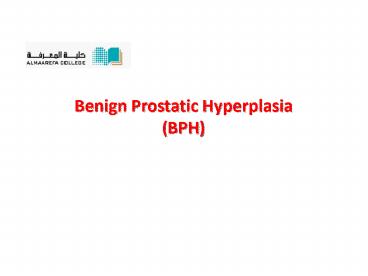Benign Prostatic Hyperplasia (BPH) - PowerPoint PPT Presentation
1 / 26
Title:
Benign Prostatic Hyperplasia (BPH)
Description:
Benign Prostatic Hyperplasia (BPH) The prostate: Walnut-shaped gland surrounds the urethra. Prostate weights about 20g. Measures about 4 X3X2. Apex = inferior portion ... – PowerPoint PPT presentation
Number of Views:202
Avg rating:3.0/5.0
Title: Benign Prostatic Hyperplasia (BPH)
1
Benign Prostatic Hyperplasia(BPH)
2
The prostate
- Walnut-shaped gland surrounds the urethra.
- Prostate weights about 20g.
- Measures about 4 X3X2.
- Apex inferior portion of prostate.
- Base superior portion and continuous with
bladder neck.
3
Lobes of the Prostate
- Anterior lobe
- Median lobe
- Two lateral lobes
- Posterior lobe
Image Source SEER Training Website
4
Histology of the prostate
- The prostatic gland consists of glandular
component and fibromuscular stroma. - The glandular component is formed of prostatic
acini arranged in lobules. The acini are highly
folded and lined by epithelial cells. The
percentage of glandular tissue vary between the
different zones of the gland.
5
Prostate zones
- Central zone (CZ)
- Cone shaped region that surround the ejaculatory
ducts (extends from bladder base to the
verumontanum) - Accounts for 25 of glandular tissue.
- Peripheral zone (PZ)
- Posterolateral prostate
- Accounts for the majority of glandular tissue.
- The site of prostate adenocarcinoma
6
- Transitional zone (TZ)
- Surrounds the prostatic urethra proximal to the
verumontanum - Accounts for only 5-10 of glandular tissue.
7
(No Transcript)
8
Functions of the prostate
- Secretes prostatic secretions.
- During orgasm, prostate muscles contract and
propel ejaculate out of the penis
n
n
9
Benign prostatic hyperplasia (BPH)
10
Causes BPH
- BPH is part of the natural aging process, like
getting gray hair or wearing glasses - BPH cannot be prevented
- BPH can be treated
n
n
n
11
Proposed Etiologies of BPH
- The causes of benign prostatic hyperplasia are
not fully understood. Several theories have been
proposed to explain BPH, the most accepted one is
hormonal changes.
12
- Estrogen may play a role in BPH. As men age,
testosterone levels drop, and the proportion of
estrogen increases, possibly triggering prostate
growth. - In addition to the mechanical effects of the
enlarged prostate, clinical symptoms of lower
urinary tract obstruction are also due to smooth
muscle-mediated contraction of the prostate. The
tension of prostate smooth muscle is mediated by
the a1-adrenoreceptor localized to the prostatic
stroma.
13
Morphological features of BPH
- Gross Findings
- The periurethral part of the gland is most
commonly involved. - Overall, the gland is enlarged, often reaching
massive size, and has a firm, rubbery
consistency. Small nodules are present throughout
the gland, usually 0.51 cm in diameter but
sometimes much larger. Some of the larger nodules
show cystic change. - The urethra appears slit-like and compressed.
14
(No Transcript)
15
- Microscopic Findings
- The nodules are composed of a variable mixture of
hyperplastic glandular elements and hyperplastic
stromal muscle. The glands are larger than normal
and lined by tall epithelium that is frequently
thrown into papillary projections.
16
BPH
17
(No Transcript)
18
Clinical Course
- Symptoms of nodular hyperplasia, when present,
relate to two secondary effects - 1. Compression of the urethra with difficulty in
urination. - 2. Retention of urine in the bladder with
subsequent distention and hypertrophy of the
bladder, infection of the urine, and development
of cystitis and renal infections. - Symptoms
- Patients experience frequency, nocturia,
difficulty in starting and stopping the stream of
urine, overflow dribbling, and dysuria (painful
micturition). In many cases, sudden, acute
urinary retention appears for unknown reasons and
persists until the patient receives emergency
catheterization.
19
- In addition to these difficulties in urination,
prostatic enlargement results in the inability to
empty the bladder completely, so a considerable
amount of residual urine is left. This residual
urine provides a static fluid that is vulnerable
to infection. On this basis, catheterization or
surgical manipulation provides a real danger of
the introduction of organisms and the development
of pyelonephritis.
20
- Many secondary changes occur in the bladder, such
as hypertrophy and diverticulum formation.
Hydronephrosis or acute retention, with secondary
urinary tract infection and even uremia, may
develop. - BPH is not considered to be a premalignant lesion.
21
- Treatment of BPH
- A. Mild cases
- May be treated without medical or surgical
therapy, by decreasing fluid intake, especially
prior to bedtime moderating the intake of
alcohol and caffeine-containing products and
following timed voiding schedules. The most
commonly used and effective medical therapy for
symptoms relating to benign hyperplasia are
a-blockers, which decrease prostate smooth muscle
tone via inhibition of a1-adrenergic receptors.
22
- B. Moderate to severe cases
- With no response to medical therapy, a wide range
of more invasive procedures exists. - Transurethral resection of the prostate (TURP).
It is indicated as a first line of therapy in
certain circumstances, such as recurrent urinary
retention. - Laser therapy.
23
TURP
(Transurethral resection of the prostate)
- Uses an electrical knife to surgically cut and
remove excess prostate tissue - Effective in relieving symptoms and restoring
urine flow.
24
C. Open prostatectomy
- Too large prostate -- gt100 gm
- Combined with bladder diverticulum or vesical
stone surgery
25
References
- Robbins and Cotrans Pathologic Basis of
Disease. Seventh edition.
26
Thanks for Your Attention!































